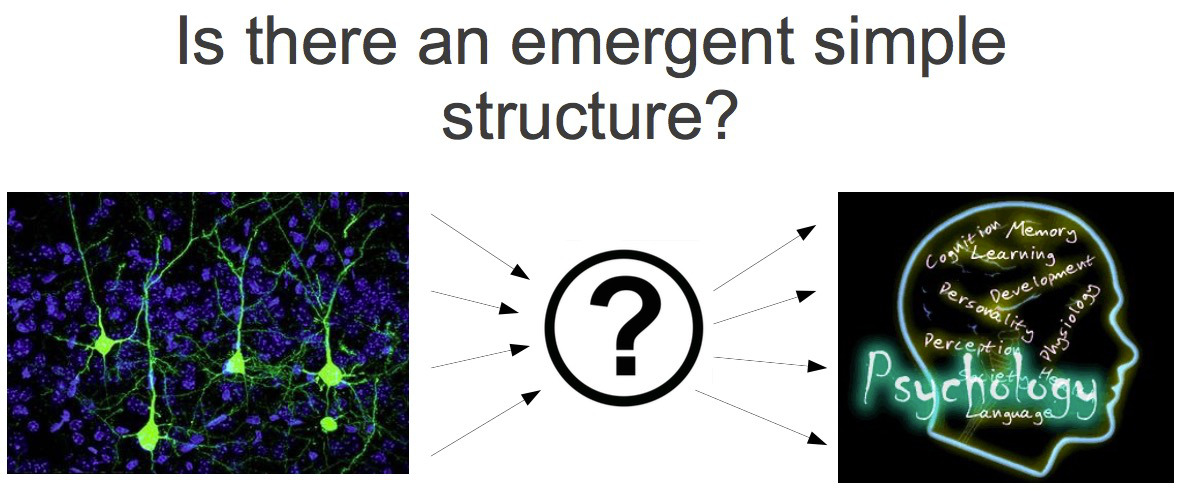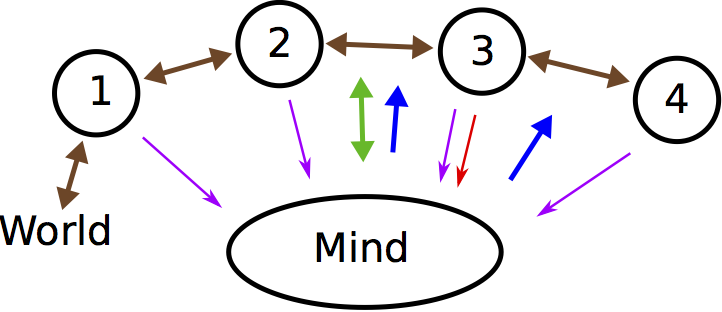
by Bradley Knockel
Disclaimer: I probably don't know what I'm talking about. And this is all very theoretical. If the following ideas are wrong, I still strongly believe that the search for an emergent simple structure is very important for the sake of knowledge itself and for possibly creating artificial intelligence.
The title is "Fundamental Psychology". What do I mean by fundamental psychology?
emotion, cognition, sexuality, personality, memory, ...
not
law, industry, philosophy, forensics, counseling, ...
I mean to explore if an emergent logical structure results from our billions of neurons. This logical structure would then give rise to the billions of behaviors and mental states that are observed. If I can figure out what this logical structure could be from psychology, then neuroscientists could look for it! This structure would unify the ideas of fundamental psychology (emotion, cognition, etc.) and would elevate psychology from being a mere description into being an explanation based on an understanding of an interconnected whole whose parts have well-understood relationships.

My basic idea is that information in the nervous system comes in three types. As the nervous system first encounters a sensory stimulus, it encodes the information. Encoded sensory information (and the final outgoing signals to muscles) is the first type. The central nervous system then has to process these sounds, sights, etc. to form the next type of information: memorable information. All types of memory (including the working memory) would be this, and it is made of music, images, movements, and anything formed from processing raw encoded information. The final (third) type is when the brain processes memories to form connections between memories (groups of memories). This includes concepts and philosophies and understanding. For example, the idea of apple brings to mind all sorts of memories: red, green, tasty, worm, the sequence of sounds in the word apple, etc. All of these memories sum to the concept of apple. In many ways, these three information types are levels. If the body (excluding the nervous system) is taken to be Level 1, then encoded information would be Level 2, memorable information would be Level 3, and connections between memories would be Level 4.
From three types of information, there are four possible tasks of the central nervous system to get information from one Level to the next: 2→3, 3→2, 3→4, and 4→3. These four tasks are what are called intelligence. 2→3 is responsible for perceiving music and 3D abstraction. 3→2 is actualizing motor signals: balancing, moving the eye, subvocalization, hand movements, etc. 3→2 allows the body to move in a fundamental way that it could always move (whereas 4→3 can involve the ordering of these movements). 3→2 cannot have the body do two opposing things at the same time, and can be emotionally expressive (I will later discuss emotions and how 3→2 is aware of them). 3→4 is the type of intelligence used when understanding these ideas. It connects memories that seem related into consistent groups. 4→3 is what recalls information. It allows us to plan our day, read these words, do elementary arithmetic, turn the sounds of a voice into language, memorize information, etc. all by recalling information. 4→3 searches from group of memories to group of memories (a memory can be in many groups) for a match. If this search is repeated, the piece of information that is looking for a match is memorized. All of these four tasks occur in the cerebrum and cerebellum.
Feedback from the four Levels creates one's emotion/mood/feelings/state of mind. This occurs as all of the Levels communicate to the "core" of the central nervous system. If Level 2 contains a painful scratch on the skin, the core of the central nervous system is told. If Level 3 is angry, bored, or proud, the core of the central nervous system is told. The only way for the central nervous system to work is to have a unifying core that governs the four fundamental intelligences based on the feedback from the Levels. The core of the central nervous system then simply does what increases the positive feedback and what reduces the negative feedback. Willpower is simply some needs expressing feedback louder than other "basic" needs. Many parallel tasks can and must be done at once because all parts of the central nervous system must all work together, coordinated by the core.
The core of the central nervous system also produces hormones, neurotransmitters, salivation, goose bumps, etc. depending on the feedback. Interestingly, moral disgust from Level 4 and a bad smell from Level 2 can both use the same "circuits" and produce a "sick to the stomach" reaction.
How then do we do complicated tasks with delayed rewards such as getting up and making a sandwich? Getting up is not inherently pleasurable! There has to be a way to remember emotions/mood/feelings/etc. so that the pursuit towards a goal can be itself pleasurable. Level 3 must remember emotions/mood/etc. alongside the actual information. This meta information about the actual information is then sent to the core of the central nervous system as an extra feedback that I will call secondary feedback. So, to get a sandwich, the memory of getting up to make a sandwich gives the secondary feedback of happily eating sandwiches, so the central nervous system automatically pursues this. Then, when you eat the sandwich, all the good feelings are stored alongside everything having to do with the sandwich to be later used the next time you are hungry for a sandwich. Also, secondary feedback is why yawns are contagious! Seeing the yawn brings back the feeling of yawning!
Below is the logical structure that has been created. The brown arrows are the flow of information between the Levels. The purple arrows are the feedback to the what I have arbitrarily called the mind, and the red arrow is the secondary feedback. The blue arrows are then the core of the central nervous system (the "mind") governing the four intelligences, which also contains the feedback itself (for example, so that Level 3 can store it). The green arrow has not yet been discussed and is needed to explain reflexes, measuring light to set sleep cycles, etc.

The power of thinking about logical structure is that nothing I have discussed is unique to human beings! Perhaps all complex-enough intelligence must follow this logical structure!
Even though I don't discuss it much here, I have various thoughts on which brain regions could be responsible for various parts of this model (just based on a college class I took about brain anatomy). A concept such as dog stored in Level 4 would be connections between parts of grey matter near the front of the cerebral cortex to parts of grey matter anywhere else in the cerebral cortex. A Level 3 memory would be connections between parts of grey matter not in the front of the cerebral cortex. I certainly am no expert, but it seems that most of our current knowledge about any brain region is just that certain abilities or feelings are associated with it. While this is crucial knowledge, I find it so lacking. It's like trying to understand a song by only studying grammar and vocabulary. I feel that the field of connectomics (comprehensively mapping neuronal connections) is what I would study if I wanted to explore further, though I wish we could somehow track individual thoughts along the connectome.
At last, I can discuss one of the main motivations I had to begin thinking about any of this: the MBTI (which are correlated to the Big Five traits). For the "lower" intelligences, 2→3 is Thinking, and 3→2 is Feeling. For the "higher" intelligences, 3→4 is Intuition, and 4→3 is Sensing. I speculate that the two lower intelligences oppose each other much like that of evaporation and precipitation in the water cycle, but they create a cycle if separated (like how precipitation must be spatially and temporally separated from evaporation to get a cycle). One of the two intelligences will become dominant, and one of the two higher intelligences will become dominant. From the idea that all four intelligences are crucial to form a working cycle, I speculate that the central nervous system's core develops two different modes when governing the intelligences. One mode avoids pain (Judging), and the other pursues pleasure (Perceiving), which are obviously two sides of the same goal. One of the modes becomes associated with the dominant intelligences. The other mode becomes associated with the remaining intelligences. Both modes working at different times allows for the separation of the opposing forces.
A somewhat independent project of mine is thinking about the emergent structure of love. Love and the associated behaviors are not a prediction of the above ideas, but are consistent with them. Love can be fully explained by specifying that the levels of a human have certain needs with their own feedback to the core of the central nervous system. These needs create the deep connections with parents, children, and romantic partners. I suggest that procreation is half of an interconnected explanation for why these connections have evolved (perhaps most other species have procreation be the only explanation). There is perhaps little hope for experimental verification of these particular ideas from neuroscience, but perhaps some clever psychologists could think of something.
Basically, my whole idea is that half of the population tends to be better at figuring out which needs should be satisfied in one's current situation (female gender), and the other half of the population tends to be better at satisfying needs (male gender). These are opposing goals that form a cycle. Both goals are necessary, but should ideally be separate (like evaporation and precipitation of the water cycle!). Besides for procreation, romance and all the other behaviors have evolved to allow this cycle to best complete itself. By only figuring out which needs to satisfy, a person may become obsessed with shopping and other superficial activities. By only satisfying needs, a person may become easily violent. Both goals are necessary to prevent such things. In fact, both goals are necessary in all careers and aspects of home life, so we should never restrict any person based on gender, especially considering that different people can accomplish the same thing differently. Artificial activities such as professional sports give the male gender the advantage, but it seems to me that a balance of genders is ideal everywhere else.
I speculate that we first learn how to do both goals from our parental figures. Then, as parental figures, we are motivated to do these goals to the best of their ability to make our children proud. Of course, we have the desire to make children and parents proud without normally being aware of why evolution wants us to be proud.
For the two goals to optimally come together to form a cycle, there are stages: attraction then romantic touch then sexual intimacy. The whole idea of all of this is to create a dance1 where we try to be attractive (for example, by not neglecting the "other" goal) while knowing that both people are there for each other so that they are on each other's mind. Romantic partners become on our minds (much like how a parent was), so we can easily answer the question "Would ______ find this attractive?" as we go about our daily lives. Finally, sexual intimacy is a dance between foreplay and "genital fun" that mimics the overall dance between the two goals. As for the spectrum of types of human beings, I'm sure there are many ways to do this dance!
Of course, we can all do the first of these stages (attraction) when we are single. It is my hunch that we can and should be complete as single individuals before seeking more optimal situations.
1. I do not usually enjoy partner dancing. Luckily, it's just an analogy...↩